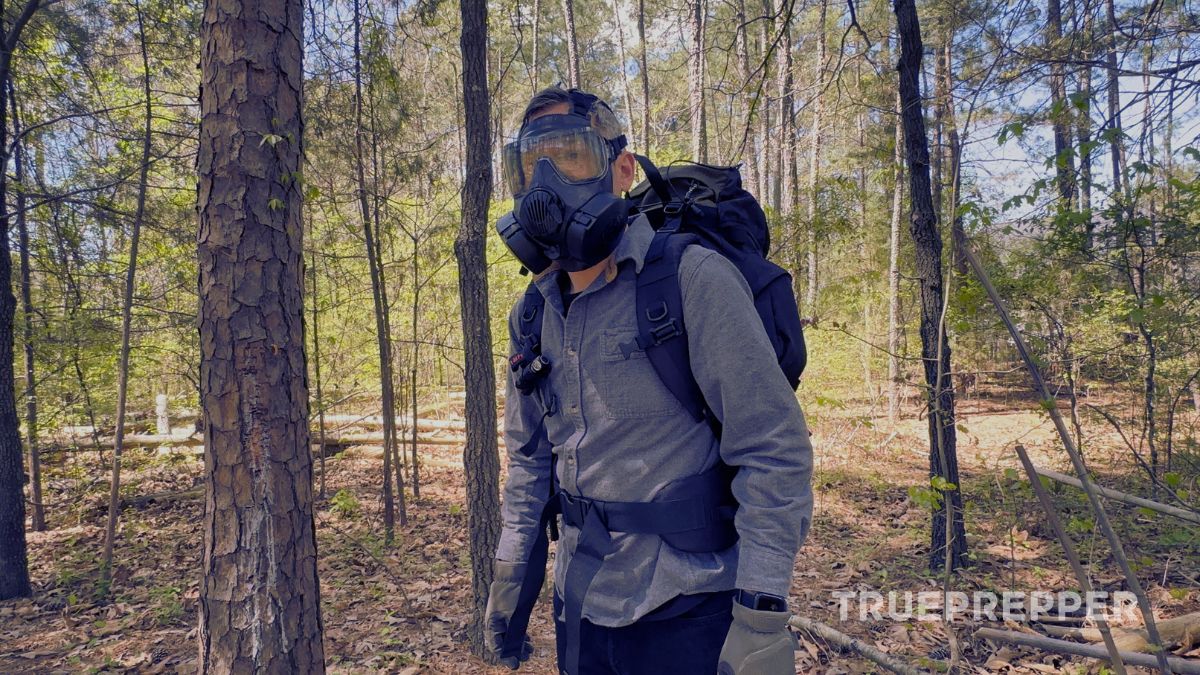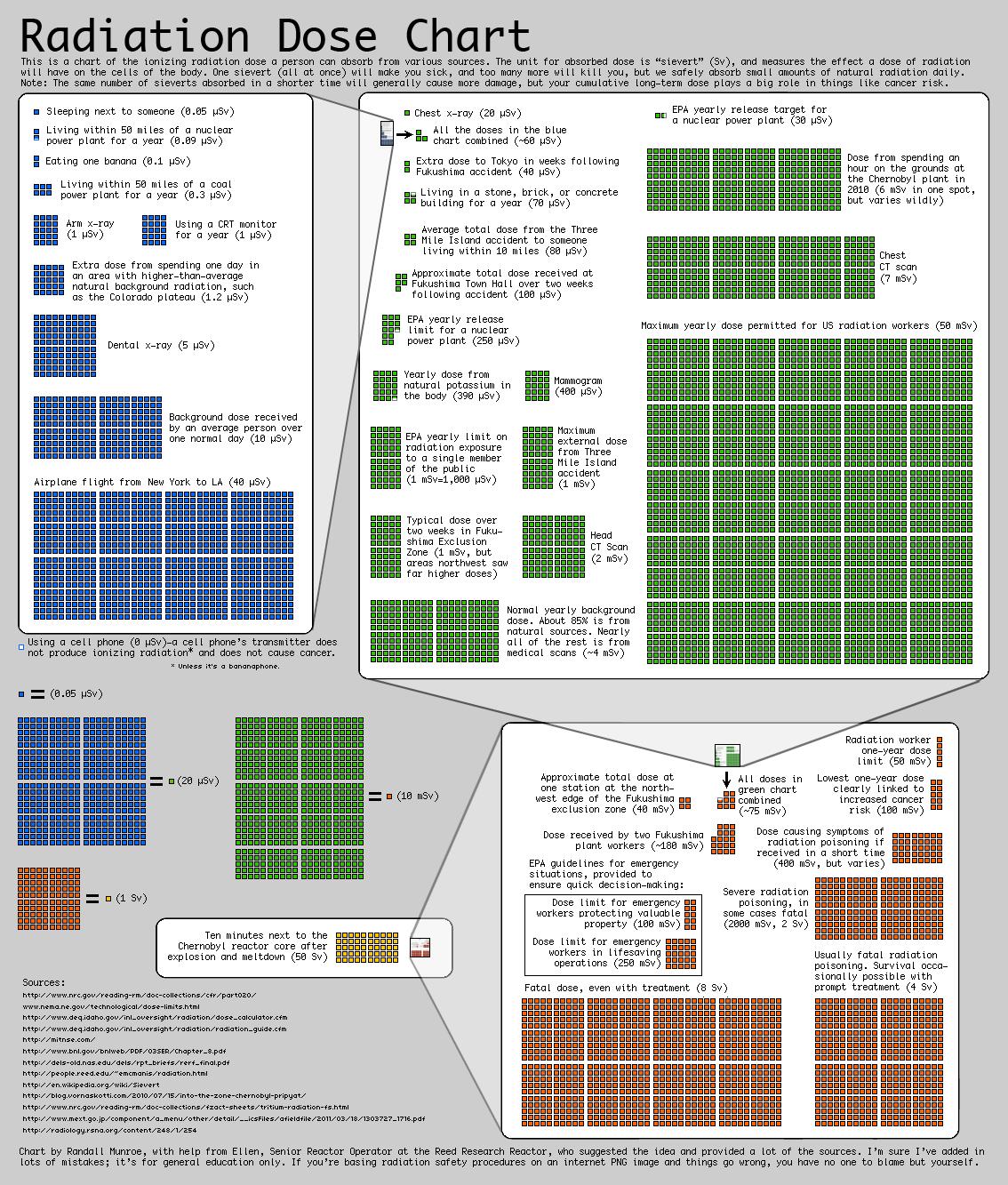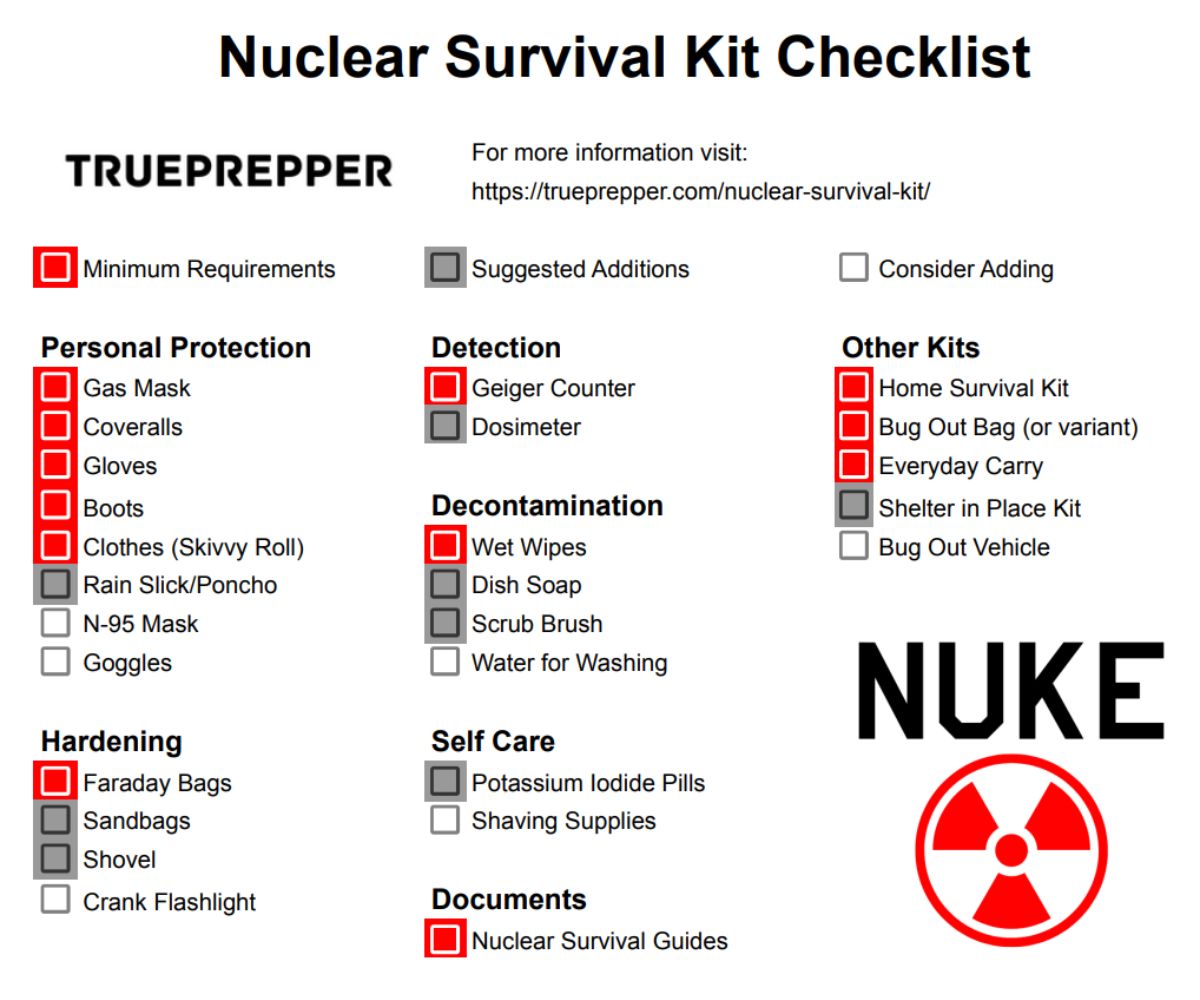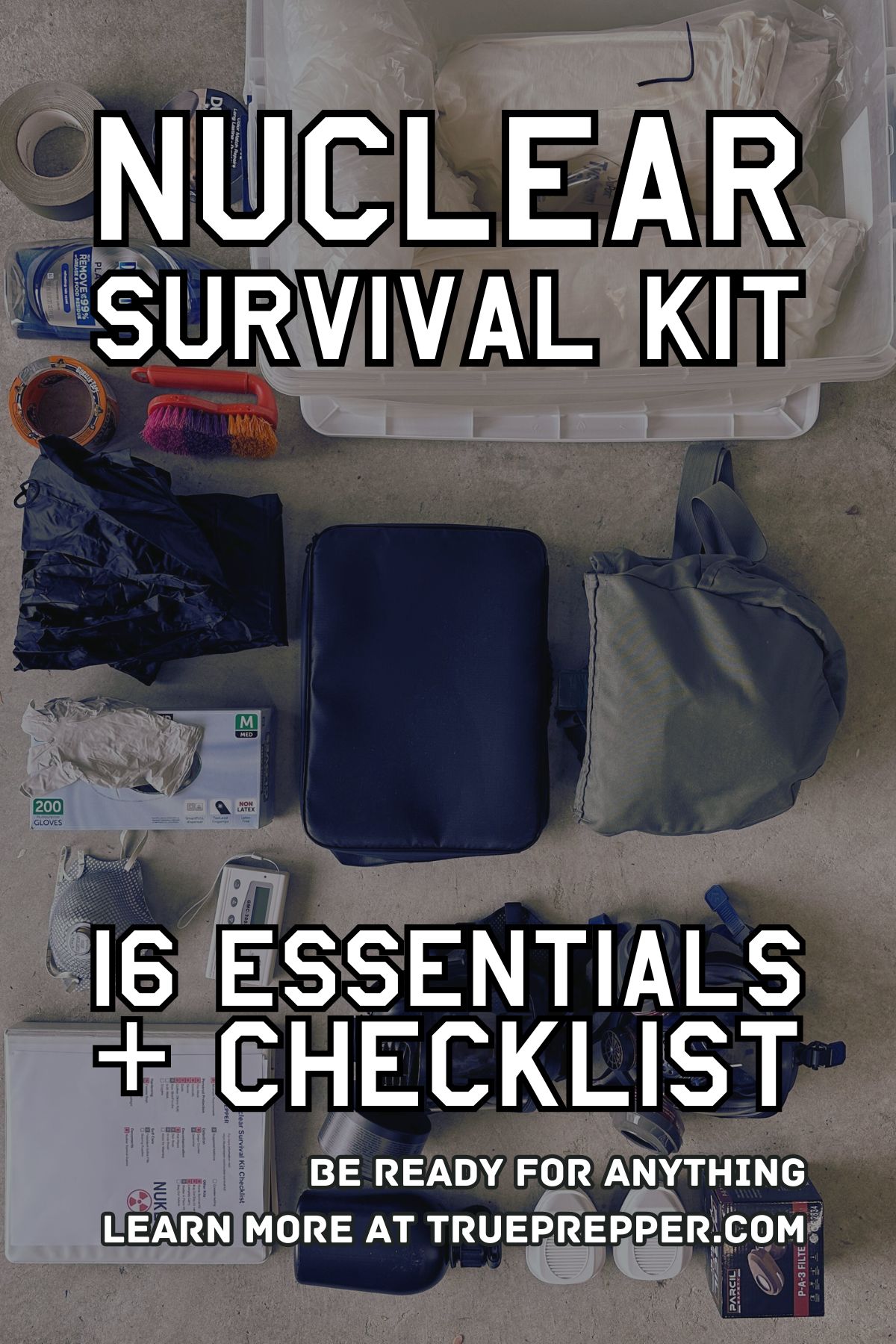Sometimes, a typical in-place survival kit just isn’t enough. One of those times is in the event of a nuclear attack, accident, or radiation emergency. That is where a nuclear survival kit comes in. Designed for personal protection and to be paired with any traditional survival kit or bug out bag, a nuclear survival kit can give you the resources to navigate one of the worst-case scenarios possible in the modern world.
This kit isn’t for everybody, but if you want to be prepared for a nuclear event, we’ve got you covered. Below we break down what a nuclear survival kit is, how essential items augment your preparedness, and share our nuclear survival kit checklist that you can download, print, or save in multiple formats.
Contents (Jump to a Section)
What is a Nuclear Survival Kit?
A nuclear survival kit can be many things with one objective: to improve your survivability through a nuclear event.
Some kits are full survival kits focused on a wide range of vulnerabilities, including nuclear threats. Others are modular kits that can stand alone or be added to typical survival kits. This is the type that we give an overview of below.
Both types of kits contain personal protective clothing- and lots of it- radiation emergencies require a lot of changing from contaminated suits or clothes. They also include equipment for nuclear hardening and radiation detection. Prevention pills like potassium iodide and decontamination kits are also common. Lastly, other kits, resources, and documents to improve your survivability are included.
Nuclear Survival Kit List
Nuclear and radiation events require a very specific set of equipment. Several of them are useful for more scenarios, but a few niche items are not. Having this gear on hand can really give you the upper hand though.
Personal Protective Clothing
Protecting your body is important- you’ll need to stay protected for at least 24 hours and then be able to get out of the fallout zone or irradiated area quickly. This can take several changes of clothes, and you’ll want to cover your body head-to-toe. You also do not want to inhale or ingest nuclear particles.
- Gas Mask: MIRA CM-6M (from our best gas mask review) – bromobutyl rubber construction at a respectable price with proven durability
- Coveralls: Rayguard 30203 – These coveralls are breathable and essentially the same as the mil-spec ‘banana suit’. You could use a HAZMAT suit here, but it’s unnecessarily hot and does not offer any better protection for radiation events.
- Gloves: Nitrile Exam Gloves – wearing several layers and popping them off as they get contaminated is a good idea, just like a biological threat.
- Boots: Have extra boots and/or shoes on hand. Like gloves, boots easily get contaminated and will need to be swapped out frequently.
- Spare Clothes: Make yourself a skivvy roll – You’ll be doing lots of changing if you get exposed to nuclear fallout.
- Rain Poncho: Arcturus Poncho (from our best survival poncho review)- another layer you can shed that will also keep you dry.

Nuclear survival- one of the few threats requiring full-face respiratory protection.
Nuclear Hardening Gear
Hardening is difficult after the fact and needs to be done ahead of time. Here is the gear we suggest:
Radiation Detection Gear
Detecting radiation and having a comparison against background level is important to know what sort of danger you are in. Here is what we suggest:
Set background levels and get comfortable with your equipment so you know what to expect.

Sean setting a background grid on his property.
Self Care and Decontamination
Radiation particles are simple to remove but difficult to neutralize. Covering your body and carefully changing clothes to clean coverage is best, but exposed areas should be washed, wiped, or scrubbed thoroughly to remove dangerous particles. Here is what we suggest:
- Potassium Iodide Pills: iOSAT (from our best iodine tablet review) – Protect your thyroid with potassium iodide pills.
- Wet Wipes: WaterWipes (from our best wet wipes review) – One of the few wipes available without additives (especially lotion).
- Dish Soap: Whatever brand you prefer that doesn’t include lotion.
- Scrub Brush: Wheel & Tire Brush – A long bristle brush for scrub decontamination.
- Extra Water for Rinsing
Other Kits and Documents
This gear and list are meant to augment your other kits. You will need food and water storage capabilities, many tools, and mobility when it comes to nuclear emergencies. Here are the kits you should already have built out:
You should also have Nuclear Survival Guides around as a reference.
What Happens if You Don’t Prepare?
Hopefully, nothing! The chances that you encounter a specific nuclear event or radiation emergency are low, but the world is an ever-changing place and threats tend to compound and escalate. There have already been two nuclear attacks, at least a dozen (documented) nuclear accidents, and countless radiation events.
While the specific threat is small for individual scenarios, the cumulative probability is higher than most people consider.
If an event does occur, the unprepared outlook is grim. Nuclear events can cause massive immediate casualties and contaminate huge areas resulting in slow, painful deaths.
If you are unprepared, this is what you can expect:
Acute Radiation Poisoning (ARS) – Also called radiation sickness, it is four phases of overexposure starting with headaches, vomiting, and diarrhea, then following with an incubation period of up to three weeks when gastrointestinal and blood disorders and skin injury follow, and then death.
Cutaneous Radiation Injury (CRI) – Also called radiation burn, the skin can get wrinkly, lose pigment, have ulcers, hair loss, and necrosis.
Dehydration – Avoiding water due to contamination will quickly dehydrate anyone without safe water access. Drinking radiation-contaminated water will dramatically increase radiation dosage through ingestion, resulting in ARS.
Starvation – Avoiding contaminated food will cause complications, especially if you do not have a way to detect if your food is safe (using a Geiger counter). Eating contaminated food will quickly result in ARS.
The last two hint at the domino effects of the nuclear event itself. They aren’t directly caused but are high-probability due to unavoidable supply chain, infrastructure, and
Time, Distance, & Shielding
The best remedy for radiation is preparing to protect yourself using time, distance, and shielding:
- Time: reduce the time exposed to radiation to reduce your exposure and dosage.
- Distance: increase your distance from the radiation source to reduce your exposure and dosage.
- Shielding: place materials between you and the radiation source to shield (measured in R-value) yourself, reducing exposure and dosage.
These are all nuanced in practice though, so we’ll go into a little more detail.
Radiation Time Exposure
Limiting your time exposure to radiation can be one of the easiest things to do if you are able to get mobile.
Nuclear Fallout Note: If there is a nuclear attack and you are dealing with fallout, you don’t want to just go charging out of your home- protected or not. The general rule for fallout is to bunker down for 24 hours and provide yourself with as much shielding protection as possible (go into the center of the home or basement if there is not a shelter pre-built).
Reducing your time exposure by going in the opposite direction of the radiation source is the best long-term solution.
This chart is one of the best visualizations developed to help understand dosage in sievert units:

Distance from Radiation Sources
Increasing your distance can be a very effective way to escape the effects of radiation. Radiation effects drop off quickly as you get further away from decaying isotopes since it follows the ‘inverse square law’.
Scattering and absorption also reduce the effect over distance, so it helps tremendously to put some distance between yourself and fallout areas and other radiation sources.
Radiation Shielding
Shielding may require some pre-planning, but it can be one of the most effective ways to mitigate radiation. Radiation shielding is putting a material between the radioactive isotope and yourself to prevent radiation particles and rays from reaching you in larger doses.
Various types of particle and electromagnetic radiation can be stopped by different amounts and types of materials:
- Alpha particles – will make you extremely sick, but can be stopped by a sheet of paper.
- Beta particles – can be stopped by a few sheets of plastic, plywood, etc.
- Gamma rays – several inches of lead needed to shield, several feet of concrete, or several yards of earth.
- Cosmic rays – not a problem on Earth thanks to our atmosphere, can be an issue for astronauts, frequent fliers, and satellites in the Van Allen Belt.
- X-rays – lead, concrete, and earth needed for shielding
- UV rays – can be stopped by sunscreen
Different radioactive isotopes can discharge different compositions of radiation, usually containing a mix of Alpha, Beta, Gamma, and X-rays for isotypes typical of nuclear attacks and accidents.
Nuclear Survival Kit Checklist
A perfect nuclear survival kit doesn’t exist- what is right for you depends on your situation and risk tolerance. That said, we have as close to perfect of a starting point for you: our complementary checklist. Not complementary as in it’s free (it is free, though)- but as in this list complements a full preparedness plan and standard survival kits.
Our checklist is available as both a pdf download and as a Google Sheet/Excel file where you can check off items yourself, and even add and subtract items from the checklist.

Nuclear Survival Kit Printable PDF Checklist
If you are looking for the simplest way to print and use the checklist above, download our printable PDF version. It is one page long on 8.5″ x 11″ paper and makes creating a kit extremely easy. Once you open the Nuclear Survival Kit PDF checklist in your browser, you can either print it directly or save it through your browser.
Nuclear Survival Kit Checklist Excel / Google Sheet
If you are looking for a comprehensive way to track your nuclear survival kit contents, open our Excel / Google Sheets version. The sheet is sharable, and you just need to copy it to your own Google Sheets account or download it to Excel to edit it. We also keep the best-reviewed item for each category linked to simplify shopping for any equipment you may find yourself missing.
Nuclear Survival Kit vs Home Survival Kit
Nuclear survival kits are designed to meet a more specific goal than general survival kits. They apply to a specific range of nuclear-related threats and focus on preparedness items to meet the challenges these present.
Nuclear survival kits focus on the ‘time, distance, & shielding’ tenet to protect yourself from a threat you cannot see, smell, or touch. Food, water, communication supplies, and other shared focuses are still extremely important, but in a nuclear survival kit, you are prioritizing NOT absorbing 8 sieverts, which is an inescapable death sentence.
If you are looking for our top-level guide with all supplies related to in-place survival at home, check out our comprehensive home survival kit:
The Next Step
Whether or not you’ve chosen to build a nuclear survival kit, our next step in this guide series stops off at EDC, or Everyday Carry. What you have on you when an unexpected disaster emerges can determine whether you can even make it to your nuclear survival kit.
Check out our Everyday Carry List here:
Keep exploring, stay prepared, and be safe.
You’ve Been Missing Out
Join the 2+ million preppers that rely on our prepping advice by subscribing to TruePrepper.
- Practical guides and tips
- Useful survival giveaways
- Free, forever
- < 0.4% of people unsubscribe
Thanks for subscribing, reading, and welcome to the club.

The post Nuclear Survival Kit List | 16 Essential Items appeared first on TruePrepper.
https://trueprepper.com/nuclear-survival-kit/
 CampingSurvivalistHuntingFishingExploringHikingPrivacy PolicyTerms And Conditions
CampingSurvivalistHuntingFishingExploringHikingPrivacy PolicyTerms And Conditions
